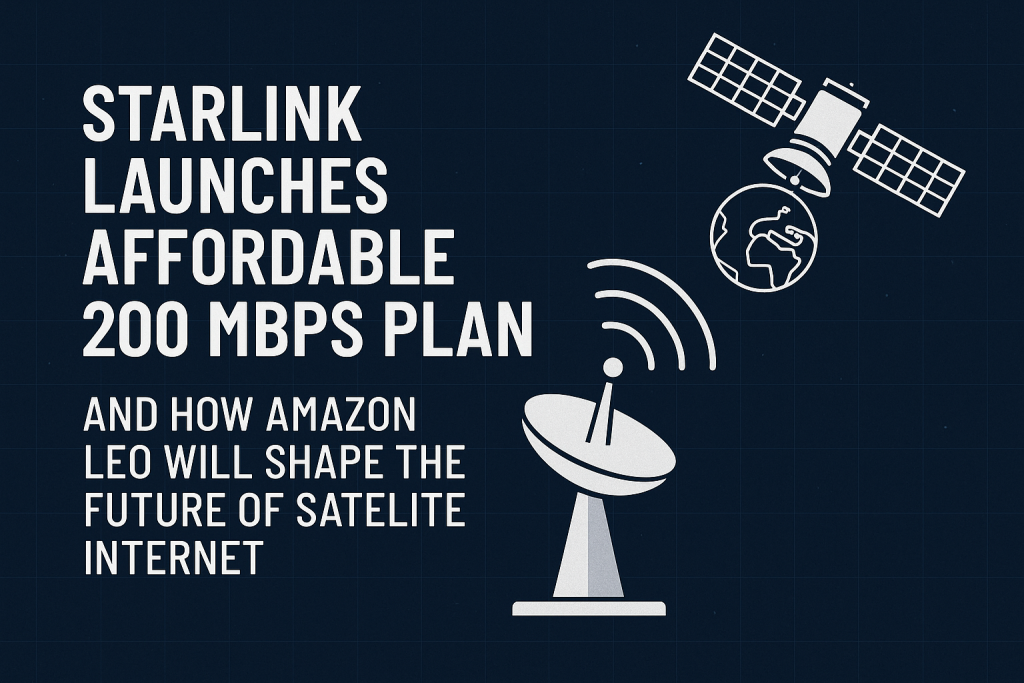
Starlink Introduces a More Affordable 200 Mbps Plan Across the U.S.
What This Means for Connectivity and Why Amazon Leo Will Heat Up the Market Soon
Satellite internet continues to evolve quickly, and the latest development is a new, more affordable Starlink plan designed to deliver typical download speeds in the 80 to 200 Mbps range. This new option brings satellite connectivity closer to traditional broadband pricing while keeping coverage available across a large portion of the United States.
At 5Gstore, we look at these announcements through the lens of practical use cases, performance expectations, and how they compare to 4G, 5G, and hybrid solutions. This new Starlink plan is a meaningful addition to the connectivity toolkit, especially for rural and underserved areas.
👉 Check your address to see what plans are available
A Look at Starlink’s New 200 Mbps Residential Lite Plan
Starlink has added a lower cost plan that still offers solid performance for general internet use. The Residential Lite option costs significantly less than the traditional residential service and still offers:
- Typical download speeds of 80 to 200 Mbps
- Upload speeds around 35 Mbps
- Wide availability across the U.S.
- A strong fit for streaming, working from home, browsing, and multi-device homes
For many homeowners or remote business sites, this plan hits a sweet spot. It reduces cost, maintains respectable performance, and makes satellite more accessible for people who only need moderate speeds but want consistent internet where terrestrial broadband is unavailable.
The trade-off is simple. You save money, but you also give up some peak performance and may see more variation depending on network congestion, weather, and dish placement. For many users this trade is well worth it.
How It Compares to Other Connectivity Options Sold by 5Gstore
5Gstore is known for helping customers choose the right connectivity for their specific deployment, and this new Starlink plan fits into the landscape in a few clear ways.
Compared to Fiber or Cable
If you have access to fiber or cable, those services still offer faster speeds, lower latency, and more consistent uploads for the price. Traditional landline broadband will continue to be the preferred choice where it exists.
Compared to 5G and 4G Fixed Wireless
In many suburban and urban areas, modern 5G routers can deliver strong speeds with lower latency than satellite. However, coverage varies heavily by location. For customers who live in areas with weak cellular service or who need something where no wires exist, satellite remains important.
Compared to Other Satellite Services
Starlink continues to lead in coverage, performance, and adoption. This new mid-tier plan gives users a more affordable way to enter the ecosystem without sacrificing too much performance.
In the world of remote offices, construction sites, rural homes, RVs, and marine customers, this new plan is positioned very well.
What Customers Should Evaluate Before Choosing This Plan
At 5Gstore, we always encourage customers to evaluate a few key items before selecting any satellite service.
- Dish placement and viewing angle. Starlink requires a clear view of the sky. Nearby trees or buildings can reduce performance.
- Upload requirements. If you do large cloud backups or video content creation, you may prefer a higher tier or an alternate technology.
- Network redundancy goals. Satellite is excellent as a backup and can pair with 5G or wired broadband for failover.
- Latency expectations. Starlink generally beats traditional satellite, yet still cannot match fiber or cable.
- Long term connectivity plans. The landscape is changing fast and a strong upgrade path matters.
For many people in remote areas, the new Starlink plan hits the right mix of affordability and capability. For others with stronger landline or cellular options, it may serve better as a backup link.
A Big Development on the Horizon
Amazon Leo Is Coming Soon
The next major wave in satellite broadband is already forming. Amazon recently rebranded its Project Kuiper initiative as Amazon Leo. The goal is simple. Build a global low earth orbit satellite network that competes directly with Starlink.
Amazon Leo appears to be targeting a range of performance tiers, including an enterprise class Ultra terminal that is expected to support gigabit level download speeds and high upload performance. While still in early deployment stages, Amazon Leo is expected to shift pricing, availability, and feature competition across the entire satellite internet industry.
For customers and businesses, this means more options, better pricing pressure, and more innovation. For 5Gstore, this represents an opportunity to help customers understand which satellite solutions will fit their needs today and which options they may want to adopt in the future.
The 5Gstore Take
Starlink’s new Residential Lite plan is a welcome addition for anyone who needs affordable broadband outside traditional service areas. The speeds are more than enough for daily use, installation is simple, and coverage is extensive. For rural homes, remote offices, and backup connections, this will be a strong option.
At the same time, the satellite landscape is about to become even more competitive. Amazon Leo will introduce new hardware, new service tiers, and new opportunities for businesses that want strong connectivity in every corner of their operation.
Banding together cellular, satellite, and hybrid solutions is where 5Gstore excels. If you need help deciding which connectivity approach fits your exact location and use case, our team can guide you through the options.

